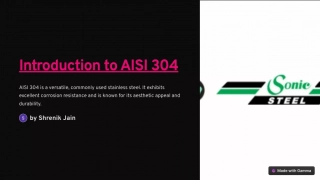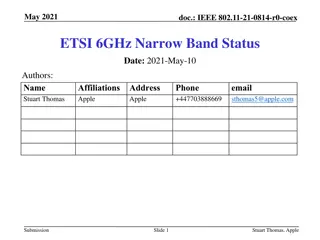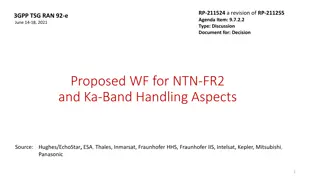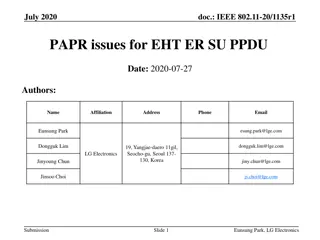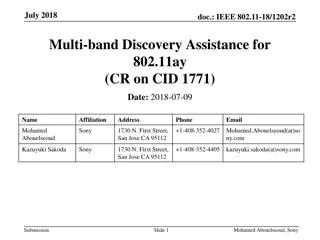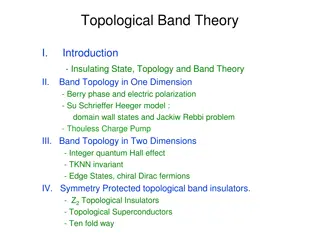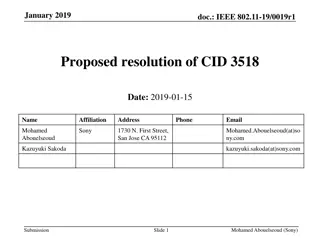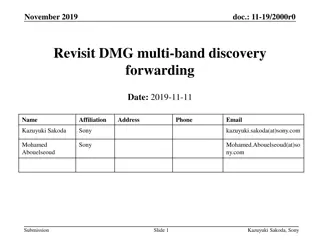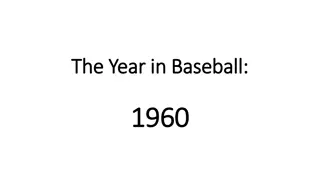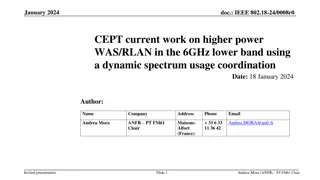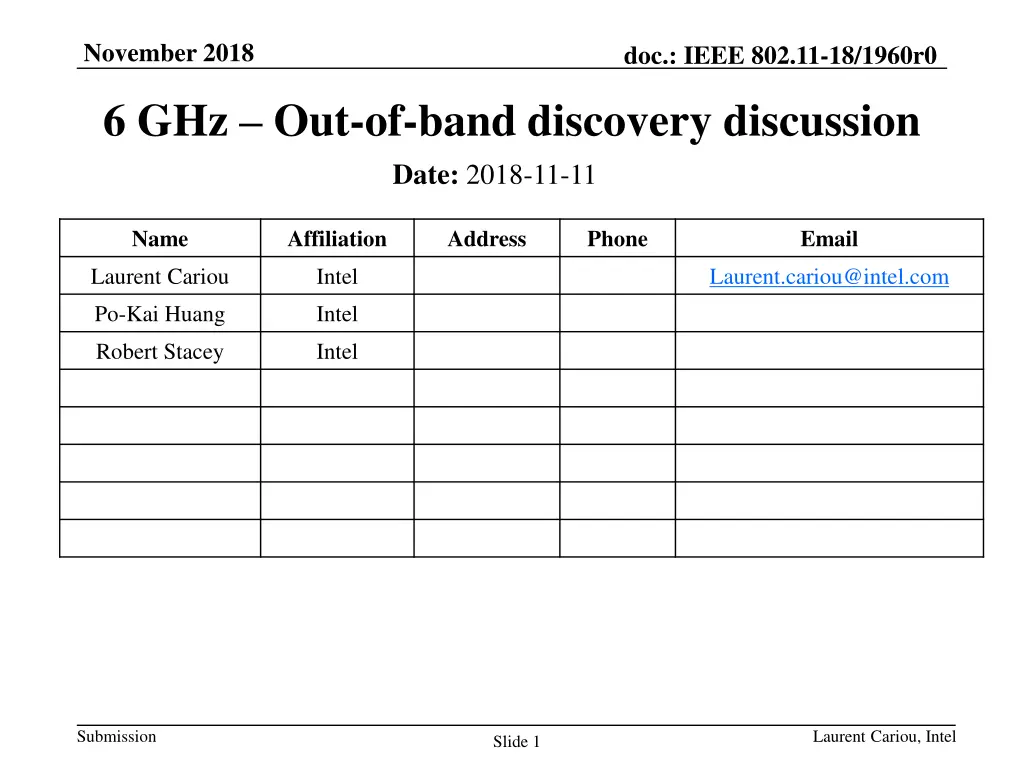
6GHz APs Discovery Discussion
Explore the discussion on discovering 6GHz Access Points (APs) to advance technology, including proposals and objectives for STAs full scan. Learn about mandatory requirements for multiband APs and the necessary information carried in the discovery element to fulfill the objectives.
Download Presentation

Please find below an Image/Link to download the presentation.
The content on the website is provided AS IS for your information and personal use only. It may not be sold, licensed, or shared on other websites without obtaining consent from the author. If you encounter any issues during the download, it is possible that the publisher has removed the file from their server.
You are allowed to download the files provided on this website for personal or commercial use, subject to the condition that they are used lawfully. All files are the property of their respective owners.
The content on the website is provided AS IS for your information and personal use only. It may not be sold, licensed, or shared on other websites without obtaining consent from the author.
E N D
Presentation Transcript
November 2018 doc.: IEEE 802.11-18/1960r0 6 GHz Out-of-band discovery discussion Date: 2018-11-11 Name Affiliation Address Phone Email Laurent Cariou Intel Laurent.cariou@intel.com Po-Kai Huang Intel Robert Stacey Intel Submission Laurent Cariou, Intel Slide 1
November 2018 doc.: IEEE 802.11-18/1960r0 Introduction This document intends to have a discussion on discovery of 6GHz APs in order to move forward It incorporates the different proposals on discovery Submission Slide 2 Laurent Cariou, Intel
November 2018 doc.: IEEE 802.11-18/1960r0 Objectives Current steps for STAs full scan: 1) First step: present list of SSIDs to user interface (no need for all IEs) 2) Second step: for one or more selected BSSIDs/SSIDs, collect all IEs and RSSI The objective is to allow STAs to discover all BSSIDs/SSIDs (part of multi-band devices) by scanning only 2.4/5GHz Include discovery element in beacons, probe response, assoc response Designed to work for single BSSID or multiple BSSID (with multiple BSSID set) First step in STAs full scan entirely done in lower bands Note: If AP/STAs support OCT, they can also complete second step at 2.4/5GHz Submission Slide 3 Laurent Cariou, Intel
November 2018 doc.: IEEE 802.11-18/1960r0 How to fulfil the objectives To fulfil the objectives, we need: 1- Mandatory requirements for multiband APs to send discovery information in lower bands 2- Define the information that is carried in the discovery element 3 - The definition/selection of the discovery elements (containers) that will carry the needed discovery information In this document, we describe these 3 items Submission Slide 4 Laurent Cariou, Intel
November 2018 doc.: IEEE 802.11-18/1960r0 1 - Mandatory requirements To achieve the objective, we need the following: If an AP operating on a 6 GHz channel has a Multiband Collocated AP operating on a 2.4 or 5 GHz channel with the same SSID, then the multiband Collocated AP operating on a 2.4 or 5 GHz channel shall advertise the information of the AP operating on a 6 GHz channel in Beacon frames and in Probe Response frames addressed to a STA supporting operation in the 6 GHz band. Need also to cover the different cases where Multiple BSSID is used If an AP operating on a 6GHz channel has an SSID for which there are no BSSIDs at 2.4/5GHz, then at least one of the Multiband Collocated APs at 2.4/5GHz shall advertise the information of this AP at 6GHz. To allow the STA to get all SSIDs by just scanning 2.4 and 5GHz: useful for the scan intended to present the list of SSIDs to the user interface Without this, the STA will need to go and scan 6GHz to make sure there are no other SSIDs. Submission Slide 5 Laurent Cariou, Intel
November 2018 doc.: IEEE 802.11-18/1960r0 1 - Mandatory requirements (cont) Probably a good idea to also mandate that in the 6GHz beacon, we provide discovery information for the 2.4/5GHz collocated APs. Submission Slide 6 Laurent Cariou, Intel
November 2018 doc.: IEEE 802.11-18/1960r0 2 What information to carry Required: BSSID, SSID (short of full), operating class, operating channel Indication that it is collocated in the same device Optional features that require signaling in discovery elements: If OCT is used: need an indication that this feature is supported If out-of-band association is recommended: good to provide this information Possibly others Good to have If the BSSID at 6GHz is part of multiple BSSID set, At least have an indication that this is the case (no beacons sent by this BSSID) provide the MaxBSSIDIndicator to help locate the right beacon/FILS DF Submission Slide 7 Laurent Cariou, Intel
November 2018 doc.: IEEE 802.11-18/1960r0 3 What element to use Multiband element Reduced Neighbor Report Modification of HE Operation element Submission Slide 8 Laurent Cariou, Intel
November 2018 doc.: IEEE 802.11-18/1960r0 Discussion on discovery elements Multi-band element: Designed specifically for discovery of collocated APs Need modifications for SSID information, handling of multiple BSSID set Optional subelement can allow to provide other information Reduced neighbor report: Already used on WFA OCE program Needs to be modified to signal that it is collocated Needs to be modified to signal optional features (OCT, out-of-band assoc, multiBSSID ) Submission Slide 9 Laurent Cariou, Intel
November 2018 doc.: IEEE 802.11-18/1960r0 Discussion on discovery elements Modification of HE Operation element has the following issues Limited to a single AP/operating channel at 6GHz: Already many APs with 2 BSSIDs at 5GHz in different channels (low band and high band), very likely to have devices with at least 2 BSSIDs on 2 operating channels at 6GHz Does not cover the discovery in case the SSID is different 2.4/5GHz APs have to be HE APs Overload of an element that is not meant for that (HE Op, when sent by the 5GHz AP is meant to carry information describing the 5GHz AP, not for describing other BSSs) Submission Slide 10 Laurent Cariou, Intel
November 2018 doc.: IEEE 802.11-18/1960r0 Compromise solution We propose to use the Reduced Neighbor Report as the single solution for the discovery of collocated APs in 2.4/5GHz beacons and probe responses Submission Slide 11 Laurent Cariou, Intel
November 2018 doc.: IEEE 802.11-18/1960r0 Discussion with regards to Neighbor report Orthogonal discussion than discov Discovery element (RNR or MBE) already included in beacons and probe response Neighbor reports are mainly used when included in BTM response frames by an AP first case: transmitted by the AP at 2.4/5GHz that is part of the same multi-band device as the 6GHz AP If a neighbor report describing the 6GHz AP is included in BTM response, it does not need to indicate that it is collocated in the same multiband device as this information is known by the STA from probe response/beacon second case: transmitted by a non-collocated AP at 2.4/5/6GHz Obviously can not indicate that it is collocated with the current AP 2 neighbor reports can be sent in a row to describe the AP at 5 and the AP at 6GHz and it is useful to know if they are collocated Submission
November 2018 doc.: IEEE 802.11-18/1960r0 Annex Submission Slide 13 Laurent Cariou, Intel
November 2018 doc.: IEEE 802.11-18/1960r0 Ex: Multi-BSSID with same SSID list at 5 and 6GHz 6GHz 5GHz Multi-BSSID set Co-located BSSID set Beacon Beacon BSSID6_ 0 SSID0 Transmit BSSID BSSID5_ 0 SSID0 Multiple BSSID element MBE or RNR BSSID6_0 BSSID6_1 SSID1 profile BSSID6_2 SSID2 profile Beacon MBE or RNR BSSID6_1, same SSID, Max BSSID Indicator BSSID5_ 1 SSID1 Beacon MBE or RNR BSSID6_2, same SSID, Max BSSID Indicator BSSID5_ 2 SSID2 Submission
November 2018 doc.: IEEE 802.11-18/1960r0 Ex: Multi-BSSID with more SSIDs at 6GHz 6GHz 5GHz Multi-BSSID set Co-located BSSID set Beacon Beacon BSSID6_ 0 SSID0 Transmit BSSID BSSID5_ 0 SSID0 MBE with BSSID6_0, with multiple BSSID element descrbing BSSID6_2, SSID2 Or RNR for BSSID6_0, and for BSSID 6_2 with ful SSID or OCT support Multiple BSSID element BSSID6_1 SSID1 profile BSSID6_2 SSID2 profile Beacon MBE or RNR BSSID6_1, same SSID, Max BSSID Indicator BSSID5_ 1 SSID1 Submission


